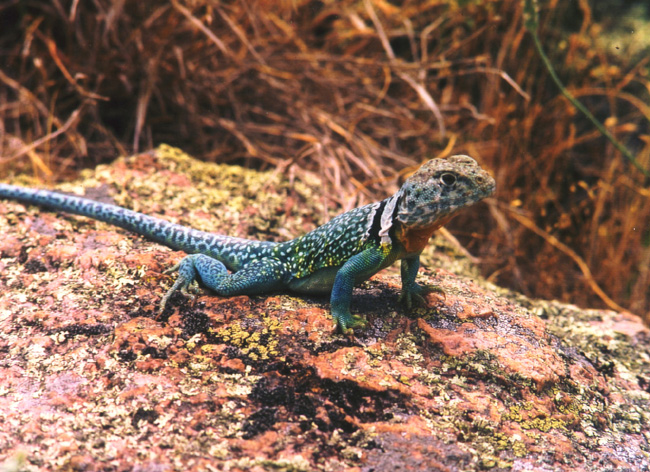
This is a male collared lizard in classic territorial posture. Note
the dramatic colors and the black and white collar.
This photograph was taken in May 1999 at the Ten Acre Rock in Johnston
County, Oklahoma.

This is a male collared lizard in classic territorial posture. Note
the dramatic colors and the black and white collar.
This photograph was taken in May 1999 at the Ten Acre Rock in Johnston
County, Oklahoma.
The collared lizard is a large, colorful, and pugnacious lizard of the south-central and southwestern US. Adults have been recorded up to 14 inches in total length (including the tail), but typically the body is about 4-5 inches and the tail is another 4-5 inches. Males are larger and more colorful than females. The collared lizard's preferred habitat is rocky hillsides and outcrops with crevices for hiding and hibernation. They avoid wooded areas and grasslands except for open rocky areas in these habitats. Collared lizards are primarily insectivorous but also feed on small vertebrates such as juveniles of other lizard species.
Collared lizards overwinter in crevices and cracks deep in their rocky habitat. They emerge in the spring, and males establish territories, which they defend vigorously against intrusion by other males. Defensive behaviors include displaying the colorful "dewlap" or throat patch, doing push-ups (a typical lizard display), lateral presentation, and chasing and biting (if the displays don't repel an intruder). Females take up residence within a male's territory, where she feeds and mates with the territory holder. Courtship includes the male displaying his bright colors while circling the female. A receptive female raises her tail, and the male mounts, bites the female on the neck to maintain his position, and copulates. Males have a paired copulatory organ (the hemipenes) so can copulate by bending his tail under the female's from either side. The female eventually lays a clutch of up to 20 eggs, which hatch in two to three months. Females frequently "double-clutch" or lay a second clutch of eggs during a given summer. Occasionally a male may have more than one female resident in his territory.
Collared lizards are diurnal and tend to be most active early and late, rather than during the heat of the day. Territorial males are frequently observed perching on rocks within their territory, to better watch for prey, females, and intruders. Collared lizards are fast runners, and may run bipedally when escaping from potential predators (or threatening herpetologists). The "mountain boomer" as they are known colloquially is the state reptile of Oklahoma. Why they are called "mountain boomer" is a mystery because they do not make noises.
There is considerable geographic variation in the intensity of color
of collared lizards. I am most familiar with the Oklahoma populations,
where the lizards in the Wichita Mountains and the Arbuckle Mountains of
southwestern and south-central Oklahoma (including the Ten-acre rock area)
are more brightly colored that populations in central, north-central, and
northeastern Oklahoma. The reason for this variation is unknown, but it
may be due at least in part to differences in availability of territories
or degree of competition for them.

A female collared lizard. Gravid females develop bright orange spots on the sides of the body. This photograph was taken in April 1995 at the Ten Acre Rock.